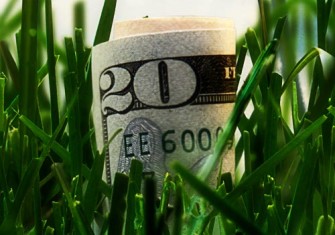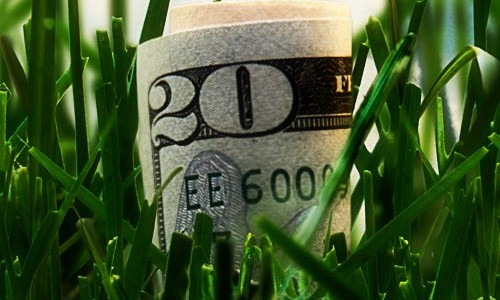Save Money on Lawn Care – 5 Tips
 As the weather warms up and flowers begin to blossom, Americans with grassy yards will soon be thinking about mowing and lawn care. The National Gardening Association estimates that U.S. households spent roughly $29.5 billion on their lawns and gardens in 2013, an average of about $347 per household. Lawn and garden costs can vary depending on factors such as the size of your yard and how much rain it receives. The easiest and least expensive lawn to take care of is a healthy one. It may take some work to get there, but healthy lawns – those that are fed regularly, watered properly and seeded at the best times of the year – fight off weeds better and look great doing it. You can keep your grass healthy without breaking your budget by following these tips.
As the weather warms up and flowers begin to blossom, Americans with grassy yards will soon be thinking about mowing and lawn care. The National Gardening Association estimates that U.S. households spent roughly $29.5 billion on their lawns and gardens in 2013, an average of about $347 per household. Lawn and garden costs can vary depending on factors such as the size of your yard and how much rain it receives. The easiest and least expensive lawn to take care of is a healthy one. It may take some work to get there, but healthy lawns – those that are fed regularly, watered properly and seeded at the best times of the year – fight off weeds better and look great doing it. You can keep your grass healthy without breaking your budget by following these tips.
Seed Your Grass
If your grass was planted 30 or 40 years ago, it’s likely to be a species that’s more prone to disease and requires more watering than newer, more drought-tolerant species of grass. Fortunately, you don’t need to rip up the old grass and replace it. You just have to overseed it. By overseeding the lawn, you’re introducing a heartier species of grass into what’s already there. Reseeding can also improve the look of newer lawns that may have some brown or worn-out patches. But it’s best to seed in the fall to yield greener, fuller grass the following spring. A lot of people seed at incorrect times, so they waste a lot of money. Fall seeding gives the grass ample time to grow that system throughout the fall, winter and early spring. When the seed is planted in the spring, it only has a few weeks to mature before the summer heat does its damage. But if you must seed in the spring, wait until the temperature reaches about 45 degrees. If the ground isn’t warm enough, the seed won’t germinate. It just blows away, or birds eat it.
Aerate Your Lawn
Another way to keep your grass healthy and your costs low is to aerate each fall. Aeration involves poking holes in your lawn to loosen the soil. You can do it yourself by renting an aerator. Be sure to rent a commercial-grade aerator, as it will work the best. A looser lawn will save you money on water. It helps eliminate compaction, and the lawn is able to absorb water better. Your lawn can be like a sponge. Aerating also helps remove lawn thatch – the tough, dark brown material that can build up between the soil and the base of the grass, giving your lawn a darker and less desirable undertone.
Time Your Waterring and Fertilizer
If your lawn has an irrigation system, the cost of watering can add up quickly. Some people make the mistake of turning on the sprinklers during the day, when it’s hot and dry and the water quickly evaporates. Others water at night, which can cause diseases or fungus in the grass because of the wet conditions. The optimal time is early in the morning, between 4 a.m. and 8 a.m. Most lawns should be fertilized every five to six weeks, and irrigated lawns require more fertilizer per application. Whether you’re fertilizing the grass yourself or hiring a professional, use a slow-release fertilizer. When you put straight fertilizer down, it goes right to the plant. There’s all this energy, and then it’s over. But if you put in a slow-release fertilizer, you’re just feeding it a little bit at a time, so it lasts longer.
Mow Tall
Golf courses may have that clean, closely cropped appearance, but you shouldn’t try to emulate it in your own yard. Set your lawn mower high to avoid cutting off more than the top third of the grass’ height, since taller grass requires less watering. There’s more leaf surface, which allows you to have a longer root system and means you can get water deeper into parts of the soil. It can make a big difference in the amount of times you need to water during the week.
Consider Grass Alternatives
Some homeowners in extremely dry climates opt to xeriscape, or landscape all or part of their yards in a way that lowers their water bills and minimizes mowing. This might save you money, but it won’t necessarily cool your lawn off. Xeriscapes act as a heat sink and make a blazing hot day hotter, sort of like trying to cool off by standing in a parking lot. Instead, create a planted area that’s designed to hold water. These bowl-shaped areas planted with water-loving plants … minimize runoff from your yard into city drains and allow water to do what it should: seep into the soil. Another approach is to add an outdoor structure like a pergola with a deck as a floor. It’ll enable rain water to pass through, cut down on mowing and create a new space in your yard for dining, relaxing, playing with the kids.

